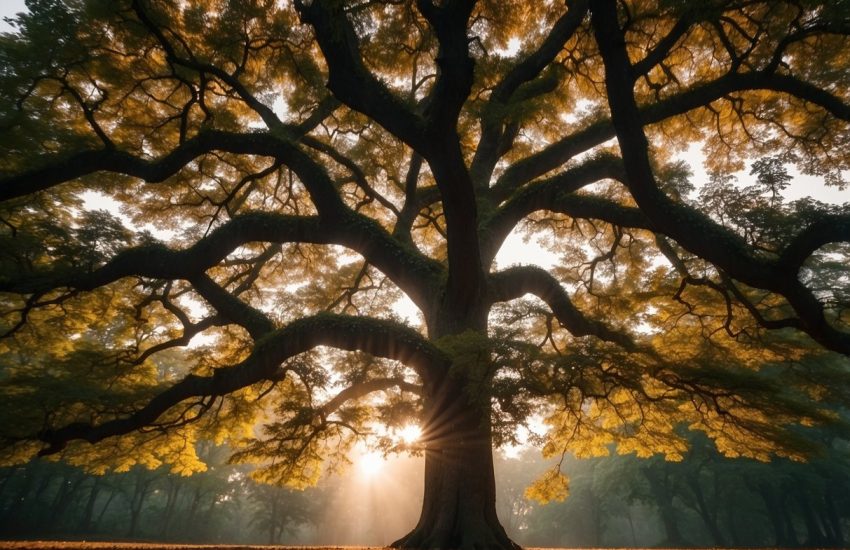12 Ornamental Trees That Will Thrive in Minnesota
Ornamental trees are the perfect way to brighten up a dull garden. Their colorful flowers and interesting leaves can add instant visual appeal to any space. Ornamental plants can also create focal points or add height and structure to a garden. When choosing ornamental trees, it is important to consider their mature size and growing requirements. Some ornamentals are fast-growing and can quickly overwhelm a small garden, while others are slow-growing and take many years to reach their full potential. Additionally, it is important to consider the locality when choosing these plants. This article examines ornamental trees that will thrive in Minnesota.
1. Kentucky Coffeetree (Gymnocladus dioicus)
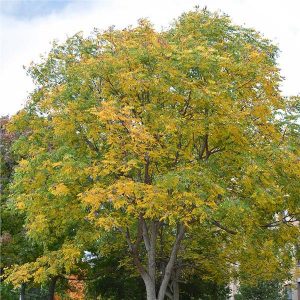
The Kentucky coffeetree (Gymnocladus dioicus) is a large deciduous tree that is native to the eastern United States. It typically grows to a height of 50-80 feet and has a spread of 30-50 feet. The Kentucky coffeetree is characterized by its large, thick trunk and rounded crown. The leaves are alternate, pinnately compound, and measure 12-24 inches long. The leaflets are ovate and have serrated margins. The flowers are small and greenish-white in color and are borne in clusters of 6-12 flowers. The fruit is a dark brown, leathery pod that measures 3-6 inches long. The Kentucky coffeetree is an important source of food for wildlife, particularly birds and squirrels. The trees also provide shelter and nesting sites for a variety of animals. Humans have also utilized the Kentucky coffeetree for its wood, which is strong and durable. Native Americans used its wood to make bows, spears, and other weapons. Today, the wood is still prized for its strength and beauty, used to make furniture, flooring, and cabinets. Besides its versatility, the tree is also used as an ornamental tree and can be found in golf parks, gardens, or yards.
2. White Fir (Abies concolor)

The White Fir (Abies concolor) is a beautiful ornamental tree native to the Rocky Mountains. It has a pyramidal shape with a dense, symmetrical crown. The bark is smooth and pale gray, with distinctively-shaped cones that hang down from the branches. White Fir is an excellent choice for use as an ornamental tree because it is relatively low-maintenance and tolerates a wide range of growing conditions. It is also relatively pest- and disease-resistant. White Fir grows best in full sun and moist, well-drained soils. It is tolerant of urban pollution and can be planted in a wide range of soil types. White Fir does not require much pruning, although it may need to be shaped occasionally to maintain its desired form. It typically lives for 60-80 years, making it a long-lasting addition to the landscape.
3. Black Ash (Fraxinus nigra)
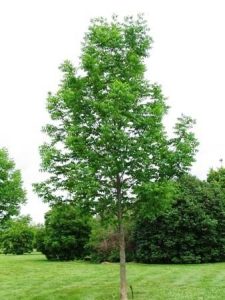
The Black Ash (Fraxinus nigra) is a good ornamental tree because of its interesting form, medium size, and fast growth rate. It has an umbrella-like canopy with a dense network of lateral branches. The branches grow perpendicular to the trunk at 90-degree angles, giving the tree a columnar shape. The leaves are glossy green and measure 8-10 inches long. They are composed of 5-9 oval leaflets that are arranged in a feather-like pattern. The leaflets have serrated margins and are connected to the central stalk by short stems. In the fall, the leaves turn yellow before they detach from the tree. The small flowers are borne in clusters and appear in early spring before the new leaves emerge. They are followed by dark purple fruits that mature in late summer. The Black Ash is an excellent choice for street or park plantings because it is tolerant of air pollution and salt spray. It grows best in moist, well-drained soils and Full Sun to Partial Shade exposure. Black Ash trees can reach a height of 40-60 feet and a width of 20-30 feet at maturity. With its stately form and attractive foliage, the Black Ash is an ideal ornamental tree for any landscape.
4. Eastern Wahoo (Euonymus atropurpureus)
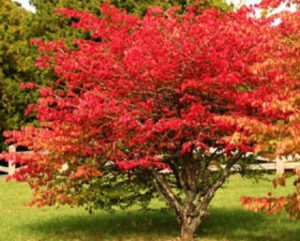
The Eastern Wahoo (Euonymus atropurpureus) is a versatile and attractive ornamental tree well suited to various landscape settings. An understory tree in its native habitat is often used as a specimen or accent tree in gardens and parks. The Eastern Wahoo has an upright, oval to round growth habit and typically reaches 15-20 feet tall at maturity. In spring, the tree produces small, inconspicuous green flowers that give way to bright red fruit. The shiny green leaves turn burgundy-red in fall, providing valuable seasonal interest. The Eastern Wahoo is adaptable to a wide range of growing conditions and is tolerant of both sun and shade. It is also relatively resistant to pests and diseases. It can be propagated by seed or cuttings and is relatively pest- and disease-free. Eastern wahoo makes an excellent addition to borders, foundation plantings, and woodland gardens.
5. Black Hills Spruce (Picea glauca var. densata)
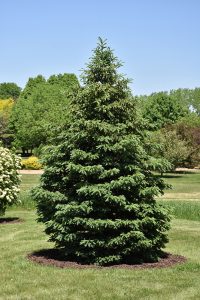
The Black Hills Spruce (Picea glauca var. densata) is a medium-sized evergreen tree native to the Black Hills region of South Dakota. It has a conical shape, and dense, dark green needles give it a pyramidal appearance. The Black Hills Spruce grows best in full sun and well-drained soils. It is tolerant of drought and cold, making it an ideal choice for Christmas trees in cooler climates. This spruce can also be used as an ornamental plant in the landscape. It is resistant to deer and rabbit browse, and its dense foliage makes it an excellent windbreak or privacy screen. The Black Hills Spruce makes an attractive holiday decoration when grown in containers. It can be placed indoors or outdoors, and its slow growth rate means it will stay small for many years. With proper care, the Black Hills Spruce will thrive for generations.
6. Prairie Dream Birch (Betula papyrifera)
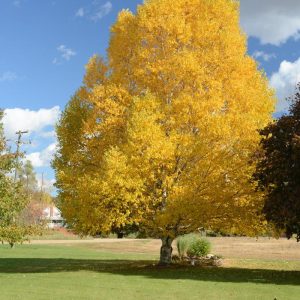
The Prairie Dream Birch is a deciduous tree that is native to North America. It grows to a height of 30-50 feet and has a trunk diameter of 12-24 inches. The bark is smooth and white, with horizontal lentils that are dark brown. The leaves are ovate-shaped and 2-4 inches long. They are green in the summer and turn yellow in the fall. The flowers are greenish-yellow and grow in clusters. The fruit is a small nutlet that is encased in a papery wing. The tree blooms from April to May and fruits from September to October. The Prairie Dream Birch is commonly used as an ornamental plant due to its attractive appearance. It can be planted in parks, gardens, and yards. It is also used as a Christmas tree in some parts of the United States. The wood of the tree is hard and close-grained, making it suitable for use in furniture, cabinetry, and floors. The beautiful bark and branches are also popular for use in floral arrangements and wreaths.
7. Bitternut Hickory (Carya cordiformis)
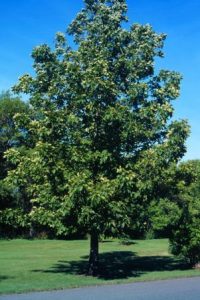
The bitternut hickory (Carya cordiformis) is a popular ornamental tree due to its unique appearance and strong wood. The bitternut hickory grows to be about 50-70 feet tall with a trunk diameter of around 18-24 inches. The leaves are alternate, simple, and pinnately compound with 5-9 oval-shaped leaflets. The leaflets are 3-6 inches long and 2-4 inches wide with serrated margins. The bark is light gray or brown and smooth when the tree is young but becomes dark gray or black and rough with age. The wood is hard, heavy, and strong, with a density of around 075 pounds per cubic foot. It is often used in furniture making and other woodworking projects. It is also a good choice for windbreaks and shade trees. The Bitternut Hickory typically blooms in April or May, and its nuts ripen in October. The tree can be found in USDA hardiness zones 4-9.
8. American Sentry Linden (Tilia americana)
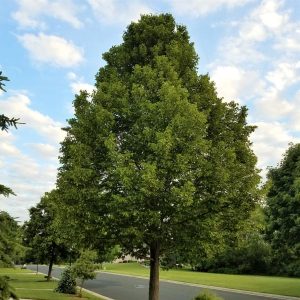
The American Sentry Linden (Tilia americana) is a medium to large deciduous tree that is native to eastern North America. It typically grows to a height of 50-70 feet and has a spread of 30-40 feet. The leaves are ovate-shaped and have a toothed margin. They are dark green in color and 4-8 inches in length. The flowers are small and yellow, arranged in clusters of 3-5. The fruit is a small, dry capsule that contains numerous tiny seeds. The bark is gray in color and smooth, with occasional shallow fissures.
The American Sentry Linden is an adaptable tree that tolerates a wide range of growing conditions. It prefers full sun but can also grow in partial shade. It prefers moist, well-drained soils but is also tolerant of dry soils. Once established, it is relatively drought tolerant. This tree is relatively free of disease and insect pests. It is susceptible to leaf spots and powdery mildew. Japanese Beetles may also feed on the leaves.
The American Sentry Linden makes an excellent shade tree for home landscapes. It can also be used as a specimen tree or planted in mass as a street tree or commercial landscape. It has a uniform growth habit and produces little to no fruit or seedlings, making it an ideal choice for landscaping.
9. Ironwood Hophornbeam (Ostrya virginiana)

Ironwood Hophornbeam (Ostrya virginiana) is a North American native deciduous tree that typically matures at 30-50′ tall with a rounded crown. It is noted for its striking, iron-gray bark, which exfoliates in narrow strips exposing a bright orange inner bark, and its showy hanging clusters of greenish-yellow flowers, which appear in early spring before the leaves emerge. The deeply veined, ovate to elliptic, dark green leaves (5″ long) turn an attractive yellow in fall. This tree prefers full sun but tolerates some light shade and does best in moist, fertile, well-drained soils. Heavy clay soils should be avoided. It has no serious insect or disease problems and is quite resistant to damage by deer. Because of its unique appearance and resistance to urban pollution, this tree is often used as a specimen or street tree. Ostrya virginiana can be difficult to transplant due to a deep taproot. Ironwood Hophornbeam can also be used as a hedging plant or for screening purposes.
10. Siberian Larch (Larix sibirica)
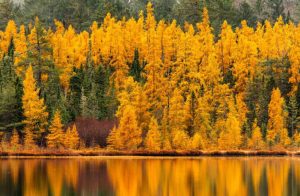
The Siberian larch (Larix sibirica) is a deciduous conifer that is native to Siberia and parts of northern China. It is a relatively small tree, growing to 20-30 meters (65-100 feet). The bark is thin and reddish-brown, while the leaves are needle-like and arranged in clusters of 10-20. The needles are green during the growing season but turn yellow or golden-brown in autumn. The cones are ovoid and measure up to 5 centimeters (2 inches) long. Siberian larch can grow in various habitats, including forests, mountains, and tundra.
The wood of the Siberian larch is strong and durable, making it an ideal material for construction and furniture-making. The tree’s striking golden foliage in fall makes it a popular choice for ornamental plantings and is often used as an accent tree in parks and gardens. Siberian larch is also a valuable source of timber for the paper industry. Every year, thousands of hectares of forest are planted with this species to create a sustainable source of paper pulp.
11. Ponderosa Pine (Pinus ponderosa)
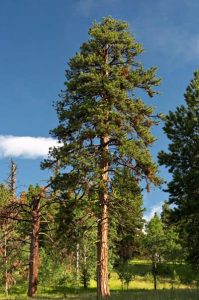
The Ponderosa Pine (Pinus ponderosa) is a large coniferous tree that is native to the western United States. It can grow up to 80 feet tall and has a reddish-brown bark that is deeply furrowed. The needles of the Ponderosa Pine are up to 18 inches long and are arranged in bundles of three. The cones are 3-6 inches long, and the seeds are contained within a hard, woody shell. The Ponderosa Pine has a distinctively sweet vanilla scent, which has made it a popular ornamental plant. The essential oils of the tree are used in aromatherapy and have been found to have soothing and stress-reducing effects. It is also said when you break the twig of the tree, it has a smell similar to oranges. In addition, the wood of the Ponderosa Pine is strong and durable, making it an excellent material for construction and furniture-making. Consequently, the Ponderosa Pine is an important tree both for its aesthetic value and its utility and will make a unique addition to any yard or garden.
12. Black Cherry (Prunus serotina)
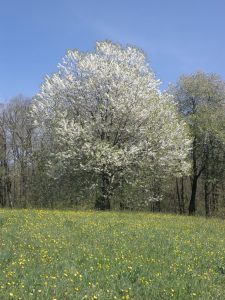
The Black Cherry (Prunus serotina) is a deciduous tree that is native to North America. It is a member of the rose family and is related to chokecherry, peach, and plum. The black cherry is a medium to large tree that can grow up to 50 feet tall. It has a spreading crown with branches that droop at the tips. The bark is dark brown to black and is smooth when young, but it becomes scaly and fissured with age. The leaves are dark green, alternately arranged, and ovate with serrated margins. The flowers are small, white, and borne in clusters. The fruit is a dark purple drupe that is 3/4 to 1 inch in diameter. The black cherry is a popular ornamental tree due to the contrast between dark and white colors from the tree, in that the flowers are bright while the foliage is dark.


